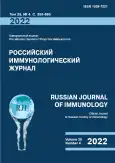Роль врожденных ошибок иммунитета в группе детей с летальными исходами на первом году жизни
- Авторы: Черемохин Д.А.1,2, Тузанкина И.А.2,3,4, Черешнев В.А.2,3, Болков М.А.2,3, Шинвари Х.3
-
Учреждения:
- ГАУЗ СО «Клинико-диагностический центр “Охрана здоровья матери и ребенка”»
- ФГБУН «Институт иммунологии и физиологии» Уральского отделения Российской академии наук
- ФГАОУ ВО «Уральский Федеральный университет имени Первого президента России Б.Н. Ельцина»
- ГАУЗ СО «Областная детская клиническая больница»
- Выпуск: Том 25, № 4 (2022)
- Страницы: 555-560
- Раздел: КРАТКИЕ СООБЩЕНИЯ
- URL: https://journals.rcsi.science/1028-7221/article/view/120155
- DOI: https://doi.org/10.46235/1028-7221-1185-ROI
- ID: 120155
Цитировать
Полный текст
Аннотация
В современном мире врожденные ошибки иммунитета (ВОИ), или первичные иммунодефициты (ПИД), являются одной из основных причин детской инвалидности и смертности, отражающих демографическое состояние человечества не только в настоящее время, но и в перспективе. В Свердловской области за последние 5 лет детей, погибших от тяжелого комбинированного первичного иммунодефицита, было около 30%. Настоящее ретроспективное исследование посвящено изучению нозологического спектра в структуре смертности детей с иммунозависимой патологией в Свердловской области, также оценке информативности анализа внехромосомных кольцевых молекул ДНК – TREC и KREC. В пользу предполагаемого диагноза первичных иммунодефицитов выступали некоторые анамнестические данные о течении пренатального периода настоящей и предшествующих беременностей – наличие угрозы прерывания на ранних сроках, наличие случаев ранней детской смерти, персистирующие вирусные и бактериальные инфекции у матери, наличие осложнений течения беременности у матери, а также клинические проявления, включающие грибково-бактериальный сепсис, генерализованную вирусную инфекцию, нарушения репарации, сниженную физиологическую толерантность, которая сопровождается аутоиммунным поражением органов и неконтролируемым системным воспалением. Проведенное исследование продемонстрировало широкий спектр нозологических форм врожденных ошибок иммунитета в структуре ранней детской смертности, среди которых встречались как классические формы первичных иммунодефицитов, так и нозологии, не относящиеся непосредственно к врожденным ошибкам иммунитета, но в фенотипе которых наблюдается явный иммунодефицит, и их непосредственную роль в статистических девиациях. Одним из основных критериев, способных отметить возможное наличие иммунозависимой патологии в раннем неонатальном периоде, оказались маркеры наивных Т- и В-клеток (TREC и KREC соответственно), в 70% изучаемых случаев почти хотя бы один этих показателей был снижен. Важно понимать, что первичные иммунодефициты уже не на столько редкая патология, как считалось прежде, и необходимо проводить своевременную и качественную диагностику во избежание непредотвратимых летальных исходов.
Полный текст
Открыть статью на сайте журналаОб авторах
Д. А. Черемохин
ГАУЗ СО «Клинико-диагностический центр “Охрана здоровья матери и ребенка”»; ФГБУН «Институт иммунологии и физиологии» Уральского отделения Российской академии наук
Автор, ответственный за переписку.
Email: dimacheremokhin@gmail.com
врач клинической лабораторной диагностики; аспирант
Россия, Екатеринбург; ЕкатеринбургИ. А. Тузанкина
ФГБУН «Институт иммунологии и физиологии» Уральского отделения Российской академии наук; ФГАОУ ВО «Уральский Федеральный университет имени Первого президента России Б.Н. Ельцина»; ГАУЗ СО «Областная детская клиническая больница»
Email: dimacheremokhin@gmail.com
д.м.н., профессор, заслуженный деятель науки РФ, главный научный сотрудник лаборатории иммунологии воспаления; ведущий научный сотрудник кафедры иммунохимии; врач – аллерголог-иммунолог научного отдела
Россия, Екатеринбург; Екатеринбург; ЕкатеринбургВ. А. Черешнев
ФГБУН «Институт иммунологии и физиологии» Уральского отделения Российской академии наук; ФГАОУ ВО «Уральский Федеральный университет имени Первого президента России Б.Н. Ельцина»
Email: dimacheremokhin@gmail.com
д.м.н., профессор, академик РАН, научный руководитель; заведующий кафедрой иммунохимии
Россия, Екатеринбург; ЕкатеринбургМ. А. Болков
ФГБУН «Институт иммунологии и физиологии» Уральского отделения Российской академии наук; ФГАОУ ВО «Уральский Федеральный университет имени Первого президента России Б.Н. Ельцина»
Email: dimacheremokhin@gmail.com
к.м.н., старший научный сотрудник лаборатории иммунологии воспаления; научный сотрудник кафедры иммунохимии
Россия, Екатеринбург; ЕкатеринбургХ. Шинвари
ФГАОУ ВО «Уральский Федеральный университет имени Первого президента России Б.Н. Ельцина»
Email: dimacheremokhin@gmail.com
аспирант кафедры иммунохимии
Россия, ЕкатеринбургСписок литературы
- Медицинский портал: https://www.inmunologia.org/images/site/grupos/inmunodeficiencias/1443.pdf (Дата обращения: 11.04.2021). Medical Portal: https://www.inmunologia.org/images/site/grupos/inmunodeficiencias/1443.pdf (Date of application April 11, 2021).
- Тузанкина И.А., Дерябина С.С., Болков М.А., Власова Е.В., Крохалева Я.М., Черемохин Д.А., Арипова Т.У., Мусаходжаева Д.А., Камалов З.С. Первичные иммунодефициты (врожденные ошибки иммунитета) в раннем возрасте: монография. Ташкент: Adast-poligraf, 2022. 232 с. [Tuzankina I.A., Deryabina S.S., Bolkov M.A., Vlasova E.V., Krokhaleva Ya.M., Cheremokhin D.A., Aripova T.U., Musakhodzhaeva D.A., Kamalov Z.S. Primary immunodeficiency (innate errors of immunity) in early age]. Tashkent: Adast-poligraf, 2022. 232 p.
- Щербина А.Ю. Первичные иммунодефициты – реалии XXI века // Вопросы гематологии, онкологии и иммунопатологии в педиатрии, 2016. Т. 15, № 1. С 8-9. [Shcherbina A.Yu. Primary immunodeficiencies: Realities of the 21st century. Voprosy gematologii, onkologii i immunopatologii v pediatrii = Pediatric Hematology, Oncology and Immunopathology, 2016, Vol. 15, no. 1, pp. 8-9. (In Russ.)]
- Bousfiha A., Jeddane L., Picard C, al-Herz W., Ailal F., Chatila T., Cunningham-Rundles C., Etzioni A., Franco J.L., Holland S.M., Klein C., Morio T., Ochs H.D., Oksenhendler E., Puck J., Torgerson T.R., Casanova J.L., Sullivan K.E., Tangye S.G. Human Inborn Errors of Immunity: 2019 Update of the IUIS Phenotypical Classification. J. Clin. Immunol., 2020, Vol. 40, no. 1, pp. 66-81.
- CEREDIH: The French PID study group. The French national registry of primary immunodeficiency diseases. Clin. Immunol., 2010, Vol. 135, no. 2, pp. 264-272.
- Park J.E., Jardine L., Gottgens B., Teichmann S.A., Haniffa M. Prenatal development of human immunity. Science, 2020, Vol. 368, no. 6491, pp. 600-603.
Дополнительные файлы









